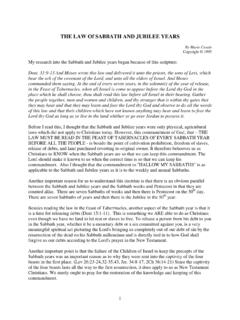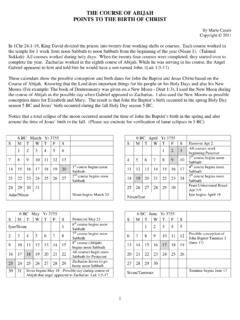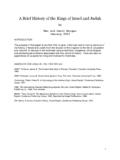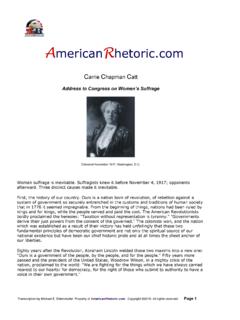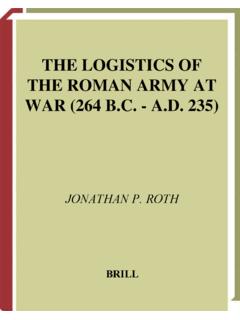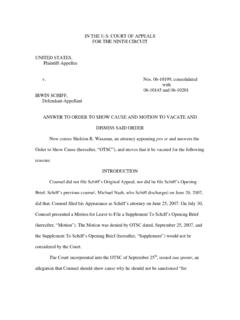Transcription of THE CENSUS OF CYRENIUS POINTS TO THE BIRTH …
1 THE CENSUS OF CYRENIUS POINTS TO THE BIRTH OF CHRIST. By Marie Casale Copyright 2011. Many see the CENSUS of CYRENIUS as an irreconcilable Biblical contradiction between Matthew and Luke. Why? Matthew says that Jesus was born during the reign of Herod the Great whom Jospehus tells us died in the spring of 4 BC. * Mat 2:1 Now when Jesus was born in Bethlehem of Judaea in the days of Herod the king, behold, there came wise men from the east to Jerusalem, Luke says he was born during a CENSUS when CYRENIUS was Governor of Syria. Josephus tells us that CYRENIUS became Governor of Syria in 6 AD. * Luk 2:1 And it came to pass in those days, that there went out a decree from Caesar Augustus, that all the world should be taxed. Luk 2:2 ([And] this taxing was first made when CYRENIUS was governor of Syria.)
2 Luk 2:4 And Joseph also went up from Galilee, out of the city of Nazareth, into Judaea, unto the city of David, which is called Bethlehem; (because he was of the house and lineage of David:). Luk 2:5 To be taxed with Mary his espoused wife, being great with child. How do we reconcile this contradiction? We must understand that Luke Chapter 2 is understood in the light of Luke Chapter 1. And Luke Chapter 1 makes clear that he and Matthew do not contradict at all. They agree. Chapter 1 tells the story of the conception of John the Baptist and of Jesus. The context of both conceptions began in the reign of Herod the Great and specifically a period of time called the Course of Abia' during which Zacharias was serving in the * Luk 1:5 There was in the days of Herod, the King of Judaea, a certain priest named Zacharias, of the course of Abia: and his wife [was] of the daughters of Aaron, and her name [was].
3 Elisabeth. As Zacharias was serving in the Course of Abijah, the angel appeared and promised that he would have a son. The Course of Abijah was the eighth week from the beginning of Nisan. It occurred the third week of May (See The Course of Abijah POINTS to the BIRTH of Christ). The year would be 6 BC in order to have both pregnancies remain within the reign of Herod and not extend past his death in the spring of 4 BC. Zacharias served two weeks in his course that included the third week of May and the following week beginning with Pentecost. He went home about the end of May. Then, according to the promise of the angel, Elizabeth became pregnant with John the Baptist sometime in June, 6 BC. * Luk 1:8 And it came to pass, that while he executed the priest's office before God in the order of his course, Luk 1:9 According to the custom of the priest's office, his lot was to burn incense when he went into the temple of the Lord.
4 Luk 1:23 And it came to pass, that, as soon as the days of his ministration were accomplished, he departed to his own house. 1. Luk 1:24 And after those days his wife Elisabeth conceived, and hid herself five months, The scriptures go on to say that Mary conceived in the sixth month of Elizabeth's pregnancy. If Elizabeth conceived in June, 6 BC, then Mary conceived in December, 6 BC. * Luk 1:31 And, behold, thou shalt conceive in thy womb, and bring forth a son, and shalt call his name JESUS. Luk 1:36 And, behold, thy cousin Elisabeth, she hath also conceived a son in her old age: and this is the sixth month with her, who was called barren. When we project nine months from the beginning of Elizabeth's pregnancy in June 6 BC, John the Baptist was born during the spring Holy Day season in March, 5 BC.
5 Notice that Luke Chapter 1 ends with the BIRTH of John the Baptist and his growth. * Luk 1:80 And the child grew, and waxed strong in spirit, and was in the deserts till the day of his shewing unto Israel. So at the end of Luke Chapter 1 we are left with Mary being three months pregnant at the BIRTH of John the Baptist. Luke chapter 2 goes on to the logical conclusion of the BIRTH of Jesus six months later. Six months from March 5 BC would be September 5 BC. LUKE 2 VERSE 1. Chapter two of Luke opens with the scripture about the CENSUS decree. * Luk 2:1 And it came to pass in those days, that there went out a decree from Caesar Augustus, that all the world should be taxed. Since Luke 1 ends with the BIRTH of John the Baptist in March of 5 BC, it makes the most sense that in those days' refers to some time after his BIRTH .
6 So at the time of the decree Mary was between three and eight months pregnant. Of course, there is no proof available that any decree from Augustus went out between March and September 5 We do have evidence that Augustus gave several decrees for a CENSUS . For example: The Deeds of the Divine Augustus, By Augustus himself Written 14 Translated by Thomas Bushnell, BSG. 8. When I was consul the fifth time (29 ), I increased the number of patricians by order of the people and senate. I read the roll of the senate three times, and in my sixth consulate (28. ) I made a CENSUS of the people with Marcus Agrippa as my colleague. I conducted a lustrum, after a forty-one year gap, in which lustrum were counted 4,063,000 heads of Roman citizens. Then again, with consular imperium I conducted a lustrum alone when Gaius Censorinus and Gaius Asinius were consuls (8 ), in which lustrum were counted 4,233,000 heads of Roman citizens.
7 And the third time, with consular imperium, I conducted a lustrum with my son Tiberius Caesar as colleague, when Sextus Pompeius and Sextus Appuleius were consuls (14 ), in which lustrum were counted 4,937,000 of the heads of Roman citizens. By new laws passed with my sponsorship, I restored many traditions of the ancestors, 2. which were falling into disuse in our age, and myself I handed on precedents of many things to be imitated in later generations. As he writes here, Augustus decreed a CENSUS in 28 BC and again in 8 BC. 8 BC is the closest CENSUS to the one Luke mentioned. But the CENSUS of 8 BC involved only Roman citizens whereas the decree Luke mentions says that Augustus ordered all the world' to be taxed or enrolled. So my theory is that Augustus expanded the CENSUS that he first decreed in 8 BC for Roman citizens to include all the world'.
8 This would include the Roman client kingdom of Judea as well. This decree must have gone out between March and September 5 BC in order for Joseph to feel obligated to respond to it when he did. Joseph would perhaps not have taken Mary on a 65- mile trip from Nazareth to Jerusalem to keep the Feast of Tabernacles in the fall of 5 BC because of her condition. But obedience to the decree of the CENSUS forced him to go. And so he traveled to Bethlehem, his ancestral town, to be enrolled. Bethlehem was only 6 miles from Jerusalem. The whole area was very crowded because of the fall feast days as well as because of the CENSUS . 5 BC September Yr 3756 BIRTH Month of Jesus S M T W T F S * Day of Trumpets (1st day of civil year): Saturday, September 2. 1 2 * Day of Atonement: Monday, September 11.
9 3 4 5 6 7 8 9. * Feast of Tabernacles 10 11 12 13 14 15 16 Saturday, September 16. * Last Great Day: 17 18 19 20 21 22 23 Saturday, September 23. * Herod still in Jerusalem at this 24 25 26 27 28 29 30 time. Total Lunar Eclipse Friday, Elul/Tishri Sept 15, 10:30 PM Jos Ant 17:6:4. Thus, Jesus was born six months after John the Baptist in the fall Holy Day season, September, 5. BC. At this time, as we learned from the article, The Reign of Herod the Great POINTS to the BIRTH of Christ , Herod was still in Jerusalem to receive the wise men. (Jos Ant 17:6:4) He had not yet left for the mineral baths beyond Jordan for his health, and from there to his winter palace in Jericho where he died in the spring of 4 BC.(Jos Ant 17:6:5, Ant 17:18:1). LUKE 2 VERSE 2. Now we come to verse 2. * Luk 2:2 ([And] this taxing was first made when CYRENIUS was governor of Syria.)
10 From Luke chapter 1 until now, the context for the births of John the Baptist and Jesus has been the year 6 BC for the two conceptions and 5 BC for the births in the reign of Herod the Great. But Luk 2:2 takes place ten years later in 6 AD when Herod was dead, Archelaus his son was deposed, CYRENIUS became governor of Syria and Judea was added to the province of Syria. Does it make sense to say that Jesus was born at this time in 6 AD? Mary was three months pregnant in March of 5 BC. What pregnancy ever lasted ten year?. 3. These are the quotes from Josephus placing Luk 2:2 at the time of 6 AD. * Ant 17:13:5 So Archelaus's country was laid to the province of Syria; and CYRENIUS , one that had been consul, was sent by Caesar to take account of people's effects in Syria, and to sell the house of Archelaus.


